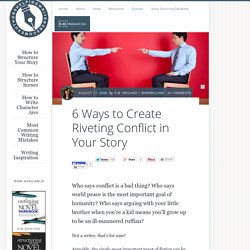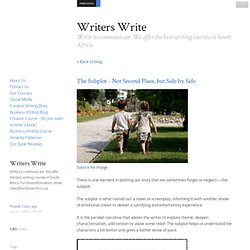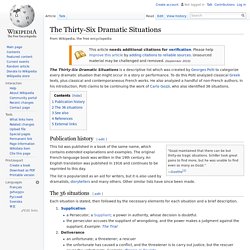

50 Romance Plot Ideas! This post was originally titled, “Master List of Romantic Conflicts,” but it really contains big ideas for entire plots.

Of course, to write an engrossing love story–whether it’s a straight-up romance, or a subplot in a different kind of book or movie–it has to have strong conflict. Like Shakespeare said, “The course of true love never did run smooth.” Obstacles give your characters the chance to change and grow as people, and to prove how much they really do love each other.
It also gives them interesting things to do. Depending on your story, it may cause sadness, terror, or hilarity before they reach their Happy Ever After. Obviously the possibilities here are endless. Beat Sheet: Pride and Prejudice. Chick 1 says: I thought for our second beat sheet we’d look at a story as far from Hot Fuzz as possible.

How to Rock Your Story's Tension. Photo cred: © Sergei Zolkin via Unsplash Today we’re talkin’ tension.

No matter your story’s plot or genre, you need to know how to nail tension in your fiction. Why? For starters, tension occurs every time a hero and a villain come in contact. And trust me, that needs to happen in your story. Without a hero, your readers have no one to route for, meaning that they won’t feel a connection to your story. 6 Ways to Create Riveting Conflict in Your Story. Who says conflict is a bad thing?

Who says world peace is the most important goal of humanity? Who says arguing with your little brother when you’re a kid means you’ll grow up to be an ill-mannered ruffian? Not a writer, that’s for sure! Arguably, the single most important tenet of fiction can be summed up in the saw “no conflict, no story.” Write a Plot Outline: Infographic. Learning how to write a plot outline is an essential skill if you want to become a prolific author.

Whether you find the distant target of reaching a substantial word length or the creation of a satisfying, forward-moving plot daunting, if you write a plot outline for your novel in advance you will have a blueprint that you can alter if necessary as you go. Our previous post on the subject suggested 7 ways you can outline your novel. We’ve since converted this information into the handy infographic below. Save it, pin it, or share it with writers you know who could benefit from having a clear structure in place before they begin writing their first drafts.
Click image to view full size Once you have your outline written, the matter of writing your first draft remains. How To Write A Novel Using The Snowflake Method. Novel Revision Stage I: Plot. The Subplot - Not Second Place, but Side by Side. There is one element in plotting our story that we sometimes forget or neglect—the subplot.

The subplot is what rounds out a novel or screenplay, informing it with another shade of emotional colour to deliver a satisfying and entertaining experience. It is the parallel narrative that allows the writer to explore theme, deepen characterisation, add tension or allow some relief. The subplot helps us understand the characters a bit better and gives a better sense of pace. Jordan McCollum: Six Steps to Stronger Character Arcs in Romances. I’m excited to welcome back JORDAN MCCOLLUM.

Today Jordan tackles the tricky topic of character arcs – with a checklist to help make them stronger. You can have the greatest plot in the world—but if your characters are flat your book will be, too. For a character to truly resonate with readers, s/he should change and grow over the course of the story. For more powerful characters, focus not just on the external plot, but the characters’ internal journey as well.
Relationship stories—romances, family dramas, “bromances,” buddy flicks, even sports movies—are all about building a relationship based on love (platonic, familial, romantic). The essential principles start with ideas on character growth from screen writer Michael Hauge. Second, each character needs some sort of “wound” in their backstory, some sort of bad experience in the past that has left them still hurting in the present. How to Structure A Story: The Eight-Point Arc. By Ali Hale - 3 minute read One of my favourite “how to write” books is Nigel Watts’ Writing A Novel and Getting Published.
How to Write a Novel Using the Snowflake Method. Monomyth. Joseph Campbell's monomyth, or the hero's journey, is a basic pattern that its proponents argue is found in many narratives from around the world.

This widely distributed pattern was described by Campbell in The Hero with a Thousand Faces (1949).[1] Campbell, an enthusiast of novelist James Joyce, borrowed the term monomyth from Joyce's Finnegans Wake.[2] Campbell held that numerous myths from disparate times and regions share fundamental structures and stages, which he summarized in The Hero with a Thousand Faces: A hero ventures forth from the world of common day into a region of supernatural wonder: fabulous forces are there encountered and a decisive victory is won: the hero comes back from this mysterious adventure with the power to bestow boons on his fellow man.[3] A chart outlining the Hero's Journey.
Summary[edit] In a monomyth, the hero begins in the ordinary world, and receives a call to enter an unknown world of strange powers and events. The 17 Stages of the Monomyth[edit] The Thirty-Six Dramatic Situations. The Thirty-Six Dramatic Situations is a descriptive list which was created by Georges Polti to categorize every dramatic situation that might occur in a story or performance.

To do this Polti analyzed classical Greek texts, plus classical and contemporaneous French works. He also analyzed a handful of non-French authors. In his introduction, Polti claims to be continuing the work of Carlo Gozzi, who also identified 36 situations. Publication history[edit] Samurai cinema. While earlier samurai period pieces were more dramatic rather than action-based, samurai movies post World War II have become more action-based, with darker and more violent characters.

Post-war samurai epics tended to portray psychologically or physically scarred warriors.[2] Akira Kurosawa stylized and exaggerated death and violence in samurai epics. His samurai, and many others portrayed in film, were solitary figures, more often concerned with concealing their martial abilities, rather than bragging of them.[2] Historically, the genre is usually set during the Tokugawa era (1600–1868), the samurai film focuses on the end of an entire way of life for the samurai, many of the films deal with masterless ronin, or samurai dealing with changes to their status resulting from a changing society. Samurai film directors[edit] Kihachi Okamoto films focus on violence in a particular fashion. Hideo Gosha, and many of his films helped create the archetype of the samurai outlaw. Zatoichi[edit] Damn it Neil, the name is Nuwanda. 3 Types of Character Arcs: Choose the Best for Your Novel. How Does Your Character Change? You know your character must change somehow over the course of your novel.
But how? And more than that, how do you sync the changes with the external plot? The middle of a novel can suffer from the dreaded “sagging middle” and it’s mainly because you don’t have a firm handle on the character’s inner arc and how it meshes with external events. I’ve found three approaches to the inner arc, each trying to laying out how the character changes.